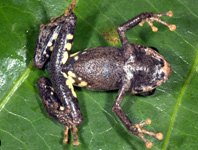Abstract
We describe two new species of Pristimantis from the Kosñipata valley in the eastern slopes of the Andes near Manu National Park, Peru. The two new species are closely related but do not overlap elevationally: P. antisuyu sp. n. occurs from 1485–1823 m a.s.l., whereas P. erythroinguinis sp. n. occurs from 930–1255 m a.s.l. Both species are readily distinguished from all other species of Pristimantis but P. cruciocularis and P. flavobracatus by possessing an iris with a cruciform pattern, no tympanum, and red bright or yellow coloration on groin. We used a Maximum Likelihood approach to infer a molecular phylogeny on a dataset composed of 27 terminals and 903 bp of the concatenated 16S rRNA and COI mitochondrial fragments. Our phylogenetic analyses indicate that, despite differing in groin coloration from red to yellow, individuals of P. cruciocularis and P. flavobracatus form a single clade, and some specimens have identical 16S sequences. Therefore, we synonymize P. flavobracatus with P. cruciocularis. The two unnamed species are closely related to P. cruciocularis. Pristimantis antisuyu sp. n. differs from P. cruciocularis and P. erythroinguinis sp. n. by having smaller yellow spots, instead of extensive red coloration, on groin and hind limbs, by being larger with proportionally longer tibias, and by having an inner metatarsal tubercle three times the size of outer metatarsal tubercle (twice as long in the other two species). Pristimantis erythroinguinis sp. n., despite having coloration very similar to P. cruciocularis, is the sister taxon to both P. antisuyu sp. n. and P. cruciocularis, and can be distinguished from the latter by having much darker ventral coloration, and no cream or yellow spots on flanks and surrounding the red inguinal marks.
References
Catenazzi, A. (2015) State of the world's amphibians. Annual Review of Environment and Resources, 40, 91–119.
https://doi.org/10.1146/annurev-environ-102014-021358Catenazzi, A., Lehr, E., Rodriguez, L.O. & Vredenburg, V.T. (2011) Batrachochytrium dendrobatidis and the collapse of anuran species richness and abundance in the upper Manu National Park, southeastern Peru. Conservation Biology, 25, 382–391.
https://doi.org/10.1111/j.1523-1739.2010.01604.xCatenazzi, A., Lehr, E. & von May, R. (2013) The amphibians and reptiles of Manu National Park and its buffer zone, Amazon basin and eastern slopes of the Andes, Peru. Biota Neotropica, 13, 269–283.
https://doi.org/10.1590/S1676-06032013000400024Catenazzi, A., Lehr, E. & Vredenburg, V.T. (2014) Thermal physiology, disease and amphibian declines in the eastern slopes of the Andes. Conservation Biology, 28, 509–517.
https://doi.org/10.1111/cobi.12194Catenazzi, A. & von May, R. (2014) Conservation status of amphibians in Peru. Herpetological Monographs, 28, 1–23.
https://doi.org/10.1655/HERPMONOGRAPHS-D-13-00003Duellman, W.E. & Lehr, E. (2009) Terrestrial-breeding frogs (Strabomantidae) in Peru. Natur und Tier Verlag, Münster, 382 pp.
Duellman, W.E., Lehr, E. & Venegas, P.J. (2006) Two new species of Eleutherodactylus (Anura: Leptodactylidae) from the Andes of northern Peru. Zootaxa, 1285, 51–64.
Frost, D. (2017) Amphibian Species of the World: an Online Reference. Version 6.0. American Museum of Natural History, New York. Available from: http://research.amnh.org/vz/herpetology/amphibia/ (accessed 13 February 2018)
Guayasamin, J.M., Krynak, T., Krynak, K., Culebras, J. & Hutter, C.R. (2015) Phenotypic plasticity raises questions for taxonomically important traits: a remarkable new Andean rainfrog (Pristimantis) with the ability to change skin texture. Zoological Journal of the Linnean Society, 173, 913–928.
https://doi.org/10.1111/zoj.12222Guayasamin, J.M., Hutter, C.R., Tapia, E.E., Culebras, J., Peñafiel, N., Pyron, R.A., Morochz, C., Funk, W.C. & Arteaga, A. (2017) Diversification of the rainfrog Pristimantis ornatissimus in the lowlands and Andean foothills of Ecuador. PLoS ONE, 12, e0172615.
https://doi.org/10.1371/journal.pone.0172615Hedges, S.B., Duellman, W.E. & Heinicke, M.P. (2008) New World direct-developing frogs (Anura: Terrarana): molecular phylogeny, classification, biogeography, and conservation. Zootaxa, 1737, 1–182.
ICZN (1999) International Code of Zoological Nomenclature. 4th Edition. The International Trust for Zoological Nomenclature, London, xxix + 306 pp.
Katoh, K. & Standley, D.M. (2013) MAFFT multiple sequence alignment software version 7: improvements in performance and usability. Molecular Biology and Evolution, 30, 772–780.
https://doi.org/10.1093/molbev/mst010Kumar, S., Stecher, G. & Tamura, K. (2016) MEGA7: Molecular Evolutionary Genetics Analysis version 7.0 for bigger datasets. Molecular Biology and Evolution, 33, 1870–1874.
https://doi.org/10.1093/molbev/msw054Lehr, E. & Duellman, W.E. (2007) Two new species of Eleutherodactylus (Anura : Leptodactylidae) from the Cordillera Occidental in Peru. Copeia, 2007, 140–149.
https://doi.org/10.1643/0045-8511(2007)7[140:TNSOEA]2.0.CO;2Lehr, E., Lundberg, M., Aguilar, C. & von May, R. (2006) New species of Eleutherodactylus (Anura : Leptodactylidae) from the eastern Andes of central Peru with comments on central Peruvian Eleutherodactylus. Herpetological Monographs, 20, 105–128.
https://doi.org/10.1655/0733-1347(2007)20[105:NSOEAL]2.0.CO;2Lehr, E. & von May, R. (2017) A new species of terrestrial-breeding frog (Amphibia, Craugastoridae, Pristimantis) from high elevations of the Pui Pui Protected Forest in central Peru. ZooKeys, 660, 17–42.
https://doi.org/10.3897/zookeys.660.11394Lynch, J.D. & Duellman, W.E. (1997) Frogs of the genus Eleutherodactylus in western Ecuador. Systematics, ecology, and biogeography. The University of Kansas Special Publication, 23, 1–236.
https://doi.org/10.5962/bhl.title.7951Meyer, C.P., Geller, J.B. & Paulay, G. (2005) Fine scale endemism on coral reefs: archipelagic differentiation in turbinid gastropods. Evolution, 59, 113–125.
https://doi.org/10.1554/04-194Ortega-Andrade, H.M., Rojas-Soto, O.R., Valencia, J.H., Espinosa de los Monteros, A., Morrone, J.J., Ron, S.R. & Cannatella, D.C. (2015) Insights from integrative systematics reveal cryptic diversity in Pristimantis Frogs (Anura: Craugastoridae) from the Upper Amazon Basin. PLoS ONE, 10, e0143392.
https://doi.org/10.1371/journal.pone.0143392Padial, J.M., Castroviejo-Fisher, S., Koehler, J., Vila, C., Chaparro, J.C. & De la Riva, I. (2009) Deciphering the products of evolution at the species level: the need for an integrative taxonomy. Zoologica Scripta, 38, 431–447.
https://doi.org/10.1111/j.1463-6409.2008.00381.xPadial JM, De la Riva I. (2009) Integrative taxonomy reveals cryptic Amazonian species of Pristimantis (Anura: Strabomantidae). Zoological Journal of the Linnean Society, 155, 97–122.
https://doi.org/10.1111/j.1096-3642.2008.00424.xParadis, E., Claude, J. & Strimmer, K. (2004) APE: analyses of phylogenetics and evolution in R language. Bioinformatics, 20, 289–290.
https://doi.org/10.1093/bioinformatics/btg412Shepack, A., von May, R., Ttito, A. & Catenazzi, A. (2016) A new species of Pristimantis (Amphibia, Anura, Craugastoridae) from the foothills of the Andes in Manu National Park, southeastern Peru. ZooKeys, 594, 143–164.
https://doi.org/10.3897/zookeys.594.8295Villacampa, J., Serrano, J. & Whitworth, A. (2017) Amphibians of the Manu Learning Center and other areas in the Manu Region. The Crees Foundation, Cusco, 278 pp.

